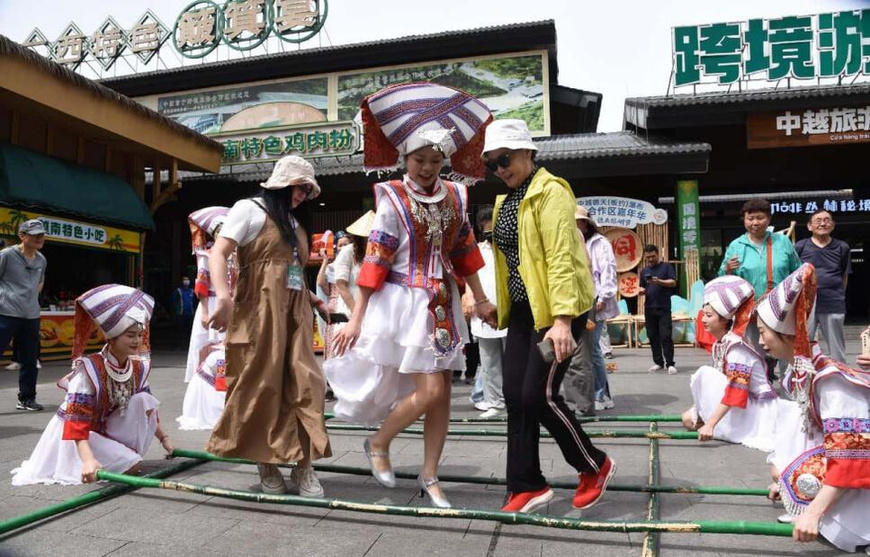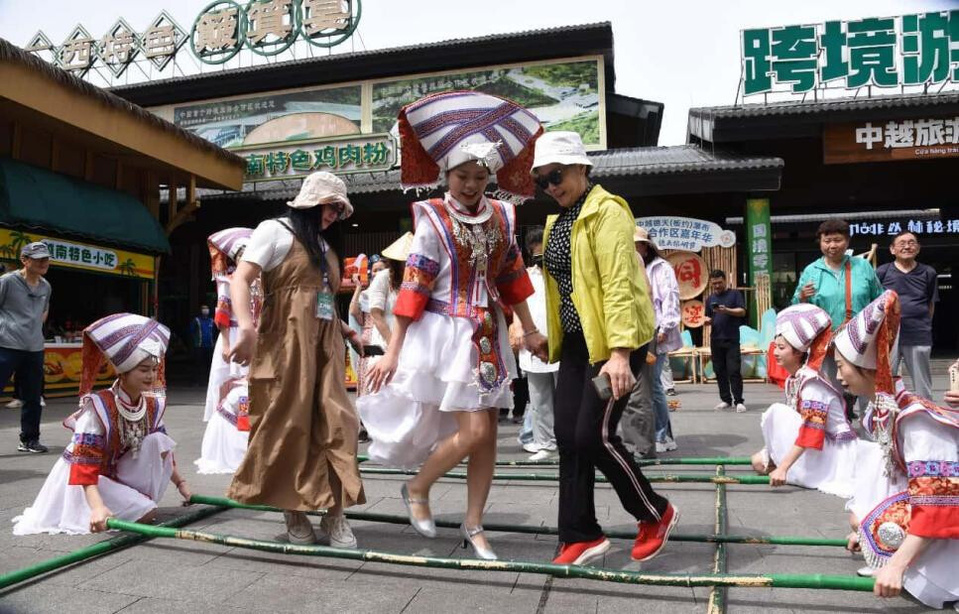By Zhang Yunhe, Qu Pei, Liu Lingling, People's Daily

Tourists join a bamboo pole dance performance at the China-Vietnam Detian-Ban Gioc Waterfall cross-border tourism cooperation zone. (Photo courtesy of the media center of Daxin county)
Along the China-Vietnam border, the China-Vietnam Detian-Ban Gioc Waterfall cascades across both nations. As the biggest cross-border waterfall in Asia and the fourth-largest cross-border waterfall worldwide, this natural marvel straddles Detian village in Chongzuo, south China's Guangxi Zhuang autonomous region and Ban Gioc village in Vietnam, a living testament to shared natural beauty and strengthening bilateral ties.
For generations, residents have shared language and customs. "We gather wood from the same mountain and drink water from the same river," locals often say. Those longstanding connections have been revitalized through the region's transformation into China's first cross-border tourism cooperation zone, turning shared geography into vibrant cultural exchanges.
Visitors now ascend misty walkways to viewing platforms where clouds hover like breath over the torrents. "What a beautiful waterfall!" exclaimed 56-year-old Tran Thi Tuyet from Vietnam.
Tran hails from Hop Tien village, Xa Binh Dinh, Kien Xuong district in Vietnam's Thai Binh province, some 500 to 600 kilometers from Detian village. "The first time I saw the waterfall, I was captivated. I fell in love with this place and with its people," she said.
She met her husband in Detian village more than two decades ago and gradually learned Chinese. Today, she runs a stall on the China-Vietnam Friendship Street in the village.
"There are tourists from all over," said Tran. "In Vietnamese, we call everyone 'brother' or 'sister' regardless of age. When I hear someone speak my native dialect, I feel a sense of home. It's like chatting with family."
The China-Vietnam Detian-Ban Gioc Waterfall cross-border tourism cooperation zone began trial operations on September 15, 2023 and officially opened on October 15, 2024.
"Travel has become much easier. Tourists can book in groups using just a passport or ID card. The experience offers not only stunning scenery but also exposure to the cultures of both countries," said Li Jiankun, marketing manager of Guangxi CTS Detian Waterfall Tourism Development Co., Ltd.
"Besides enjoying the waterfall, Chinese tourists explore Vietnamese temples while Vietnamese tourists browse Guangxi's coffee markets. Cultural exchanges flow actively on both sides," Li added.
Since its launch, the zone has received 1,838 Chinese cross-border tour groups and 639 Vietnamese groups.
Business has followed. "Vietnamese coffee, conical hats, and buffalo horn combs are popular among Chinese tourists," Tran noted. "My son now works on the Chinese side of the scenic area, ferrying tourists on bamboo rafts, and earns a stable monthly income."
"Come on, let's take a photo here!" On a recent visit, Hong Chunmei, a tourist from Sanya, south China's Hainan province, posed with her friends in a traditional Vietnamese ao dai before the waterfall. "This is my second time here. It feels even more lively than before. I've seen a lot more Vietnamese tourists this time," said Hong.
The surge in cross-border visits was also visible during the recent Yuanchun Festival, celebrated on the 15th day of the third month in the traditional Chinese calendar. "Just a few days ago, I took my family to the waterfall scenic area. It was packed with visitors. Today, during the celebrations on Shuolong Street, I recognized several of the same visitors," said local resident Qiu Yongming as he watched traditional performances.
Originally known as the "Street Founding Festival," the Yuanchun Festival commemorates the building of Shuolong Street, which began as a makeshift marketplace cleared by border troops. The street was formally built during the reign of Emperor Guangxu in the Qing Dynasty (1644-1911) and came to be known as Shuolong Street.
At an auspicious morning hour, roasted pigs were carried to the General's Temple, a traditional shrine dedicated to a historic military figure, for a ritual ceremony. Dragon dances followed, and friendly competitions filled the square, drawing participants from both sides of the border.
"Most of the visitors are local border residents. It's like gathering with relatives," said 32-year-old Ma Thi Mi, who moved from Ha Lang district, Cao Bang province, Vietnam, to Shuolong township after marriage. She now runs a noodle shop on the street.
While the Yuanchun Festival takes place once a year, Shuolong Street thrives year-round. On market days, which fall on the 2nd, 5th, and 8th days of the lunar month - Chinese and Vietnamese villagers converge to trade poultry, household goods, or local specialties, Qiu explained.
Like the waterfall itself, which roars day and night with unrelenting force, the friendship between China and Vietnam flows steadily forward, rooted in shared history, nourished by daily exchanges, and renewed by each generation.
For generations, residents have shared language and customs. "We gather wood from the same mountain and drink water from the same river," locals often say. Those longstanding connections have been revitalized through the region's transformation into China's first cross-border tourism cooperation zone, turning shared geography into vibrant cultural exchanges.
Visitors now ascend misty walkways to viewing platforms where clouds hover like breath over the torrents. "What a beautiful waterfall!" exclaimed 56-year-old Tran Thi Tuyet from Vietnam.
Tran hails from Hop Tien village, Xa Binh Dinh, Kien Xuong district in Vietnam's Thai Binh province, some 500 to 600 kilometers from Detian village. "The first time I saw the waterfall, I was captivated. I fell in love with this place and with its people," she said.
She met her husband in Detian village more than two decades ago and gradually learned Chinese. Today, she runs a stall on the China-Vietnam Friendship Street in the village.
"There are tourists from all over," said Tran. "In Vietnamese, we call everyone 'brother' or 'sister' regardless of age. When I hear someone speak my native dialect, I feel a sense of home. It's like chatting with family."
The China-Vietnam Detian-Ban Gioc Waterfall cross-border tourism cooperation zone began trial operations on September 15, 2023 and officially opened on October 15, 2024.
"Travel has become much easier. Tourists can book in groups using just a passport or ID card. The experience offers not only stunning scenery but also exposure to the cultures of both countries," said Li Jiankun, marketing manager of Guangxi CTS Detian Waterfall Tourism Development Co., Ltd.
"Besides enjoying the waterfall, Chinese tourists explore Vietnamese temples while Vietnamese tourists browse Guangxi's coffee markets. Cultural exchanges flow actively on both sides," Li added.
Since its launch, the zone has received 1,838 Chinese cross-border tour groups and 639 Vietnamese groups.
Business has followed. "Vietnamese coffee, conical hats, and buffalo horn combs are popular among Chinese tourists," Tran noted. "My son now works on the Chinese side of the scenic area, ferrying tourists on bamboo rafts, and earns a stable monthly income."
"Come on, let's take a photo here!" On a recent visit, Hong Chunmei, a tourist from Sanya, south China's Hainan province, posed with her friends in a traditional Vietnamese ao dai before the waterfall. "This is my second time here. It feels even more lively than before. I've seen a lot more Vietnamese tourists this time," said Hong.
The surge in cross-border visits was also visible during the recent Yuanchun Festival, celebrated on the 15th day of the third month in the traditional Chinese calendar. "Just a few days ago, I took my family to the waterfall scenic area. It was packed with visitors. Today, during the celebrations on Shuolong Street, I recognized several of the same visitors," said local resident Qiu Yongming as he watched traditional performances.
Originally known as the "Street Founding Festival," the Yuanchun Festival commemorates the building of Shuolong Street, which began as a makeshift marketplace cleared by border troops. The street was formally built during the reign of Emperor Guangxu in the Qing Dynasty (1644-1911) and came to be known as Shuolong Street.
At an auspicious morning hour, roasted pigs were carried to the General's Temple, a traditional shrine dedicated to a historic military figure, for a ritual ceremony. Dragon dances followed, and friendly competitions filled the square, drawing participants from both sides of the border.
"Most of the visitors are local border residents. It's like gathering with relatives," said 32-year-old Ma Thi Mi, who moved from Ha Lang district, Cao Bang province, Vietnam, to Shuolong township after marriage. She now runs a noodle shop on the street.
While the Yuanchun Festival takes place once a year, Shuolong Street thrives year-round. On market days, which fall on the 2nd, 5th, and 8th days of the lunar month - Chinese and Vietnamese villagers converge to trade poultry, household goods, or local specialties, Qiu explained.
Like the waterfall itself, which roars day and night with unrelenting force, the friendship between China and Vietnam flows steadily forward, rooted in shared history, nourished by daily exchanges, and renewed by each generation.
 Menu
Menu
 Transboundary waterfall symbolizes growing ties between China and Vietnam
Transboundary waterfall symbolizes growing ties between China and Vietnam
















